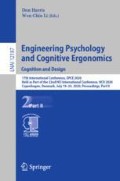Abstract
The peaceful use of nuclear energy has been attractive around the world due to its advantages of high energy density, reliability and cleanliness. Although nuclear energy has the bright prospect of eventually becoming the vital approach to reduce the global carbon emission, considering its catastrophic damage, study of severe accidents in nuclear power plant is thorny issue. Severe accidents refer to accident conditions that exceed the design basis and cause significant fuel degradation. The tasks in severe accidents have particular characteristics different from other operating conditions, such as high uncertainty of task objects, high cognitive requirements of task responses, and duty conversion in task executions. All of these characteristics interact intimately and bring great challenges to existing HFE analysis and HCI design. This paper analyzes thorough requirements of the severe accident information system from existing human computer interface design and human factors engineering, and develops the computerized severe accident management guidance system and the severe accident specific displays. Together, these elements comprise the cognitive-based severe accident information system. In the severe accident conditions, the severe accident information system will support the MCR and TSC to perform fault diagnosis and accident mitigation operations, which can tremendously alleviate the psychological pressure and workload, increase the accident response efficiency and accuracy, and improve the situation awareness of relevant personnel.
Access this chapter
Tax calculation will be finalised at checkout
Purchases are for personal use only
References
IAEA: No. SSR-2/1 (Rev. 1). Safety of nuclear power plants: design. International Atomic Energy Agency (IAEA), Vienna (2017)
Asmolova, V., Ponomarev-Stepnoyb, N.N., Strizhov, V., et al.: Challenges left in the area of in-vessel melt retention. Nucl. Eng. Des. 209(1–3), 87–96 (2001)
Johnson, G.L.: Instrumentation, control, and human system interface contributions to historical severe accidents. In: Nuclear Plant Instrumentation, Control and Human-Machine Interface Technologies (NPIC & HMIT), San Francisco, CA (2017)
Johnson, G.L.: Severe nuclear accidents: lessons learned for instrumentation, control, and human factors. Electric Power Research Institute (EPRI), Palo Alto, CA (2015)
O’Hara, J.M., Higgins, J., Fleger, S.: Human factors engineering program review model (NUREG-0711) revision 3: update methodology and key revisions. Office of Scientific & Technical Information Technical Reports (2012)
Etc. Regulation of the NSSC No. 12. Regulations on technical standards for radiation safety control. Nuclear Safety and Security Commission, Republic of Korea (2014)
GB 13630. 核电厂控制室设计. 中国国家标准化管理委员会 (2015)
IEC 60964 (Rev. 3): Nuclear power plant – control rooms – design. Inclusive Engineering Consortium (2018)
Gilmore, W.E.: Human factors guidance for building a computer-based procedures system: how to give the users something they actually want. In: Yamamoto, S., Mori, H. (eds.) HCII 2019. LNCS, vol. 11569, pp. 303–316. Springer, Cham (2019). https://doi.org/10.1007/978-3-030-22660-2_21
Naikar, N., Hocroft, R., Moylan, A.: Work domain analysis: theoretical concepts and methodology (2005)
Kaber, D.B., Segall, N., Green, R.S., et al.: Using multiple cognitive task analysis methods for supervisory control interface design in high-throughput biological screening processes. Cogn. Technol. Work 8(4), 237–252 (2006). https://doi.org/10.1007/s10111-006-0029-9
Rasmussen, J.: Skills, rules, and knowledge; signals, signs, and symbols, and other distinctions in human performance models. IEEE Trans. Syst. Man Cybern. SMC-13(3), 257–266 (2012)
Author information
Authors and Affiliations
Corresponding author
Editor information
Editors and Affiliations
Rights and permissions
Copyright information
© 2020 Springer Nature Switzerland AG
About this paper
Cite this paper
Zhi, Z., Wang, Q., Lian, H., Wang, Y., Song, F., Zhang, S. (2020). Cognitive-Based Severe Accident Information System Development in a Human Factors Project. In: Harris, D., Li, WC. (eds) Engineering Psychology and Cognitive Ergonomics. Cognition and Design. HCII 2020. Lecture Notes in Computer Science(), vol 12187. Springer, Cham. https://doi.org/10.1007/978-3-030-49183-3_9
Download citation
DOI: https://doi.org/10.1007/978-3-030-49183-3_9
Published:
Publisher Name: Springer, Cham
Print ISBN: 978-3-030-49182-6
Online ISBN: 978-3-030-49183-3
eBook Packages: Computer ScienceComputer Science (R0)

